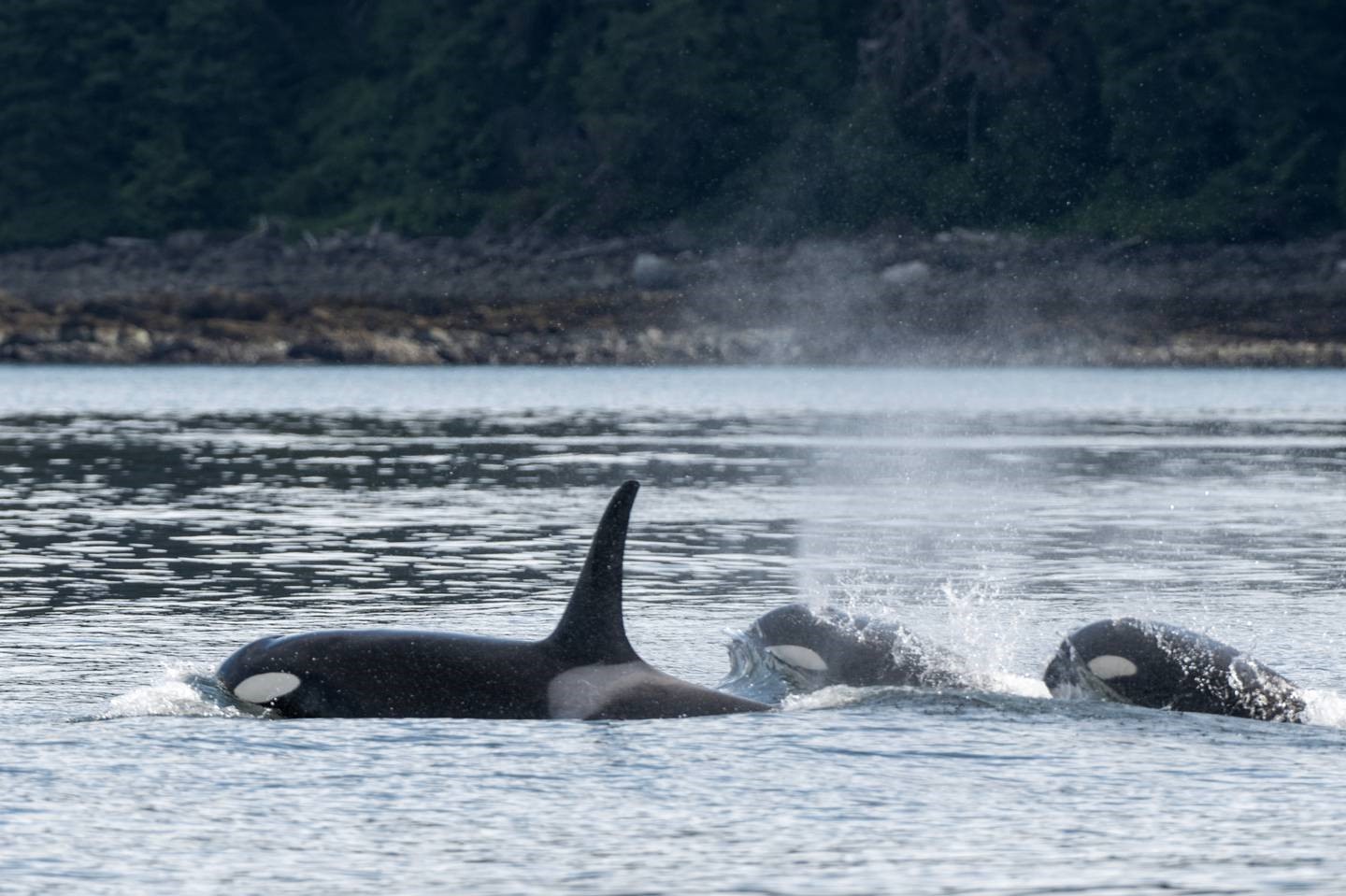Bering Sea Bottom Trawlers Reduce Killer Whale Take This Year as New Gear Shows Promise
Anchorage Daily News, October 3, 2024 – By Hal Bernton –

Three orcas from a pod of several surface near the north end of Douglas Island near Juneau on June 8, 2024. (Marc Lester / ADN)
Trawlers targeting flatfish in the Bering Sea deployed underwater web fences this summer to try to keep killer whales from getting entangled in their nets pulled along the ocean bottom. During a season that stretched from May to September, one killer whale was caught, an improvement from last year when nine whales were accidentally taken.
The web fence stretches across a wide swath of the net mouth, acting as a barrier to whales while not blocking fish passage into the net. And this year’s reduced killer whale toll has left industry officials cautiously optimistic that the fences, when fitted properly to different net designs, can keep the whales from being brought aboard the vessels as bycatch.
“We’re hopeful that we have come up with a good solution here. But these whales are really intelligent. They’re adaptive. And what works one season may not work the next,” said Chris Woodley, executive director of the Groundfish Forum, an industry trade association representing five companies with a fleet of 19 bottom trawlers that catch, process and freeze fish off Alaska.
The killer whale was caught in June in a deep area of the Bering Sea where five bottom trawl vessels pursued a mix of flatfish such as Greenland turbot and black cod.
The incident was disclosed this week by industry officials, who were scheduled to testify about their avoidance efforts at a Thursday meeting of the North Pacific Fishery Management Council in Anchorage.
The killer whale take also was confirmed by a NOAA Fisheries spokeswoman who said that the animal had died, and a federal observer took tissue samples for analysis. The vessel that caught the killer whale immediately withdrew from that fishery, according to Marjorie Mooney-Seus, who is based at NOAA’s Alaska Fisheries Science Center in Seattle.
Last year, the take of nine killer whales by the bottom trawlers was far higher than in recent years, and triggered more scrutiny of a fleet that has long drawn criticism for a wide range of bycatch including halibut and crab, which are prohibited species for these vessels and must be discarded. A NOAA Fisheries investigation found that one of the killer whales was seriously wounded but alive when released, six died after they became entangled with nets, and two were already dead when they entered the nets.
The 2023 surge in killer whale takes prompted an expanded research effort — funded by the fishing industry and federal government — to develop better gear to keep them out of the nets. Earlier this year, nearly a dozen researchers and fishing boat captains went to Memorial University in St. John’s, Newfoundland, to test out the fence design in a large flume tank that can pulse with a current to simulate underwater conditions and has a large glass window for observation.
“You can see what the net shape looks like when you’re setting the gear, and when you’re hauling it back and when it’s actually on the bottom during the fishing process,” said Sarah Webster, the science project director for the Alaska Seafood Cooperative, an industry group that seeks to improve management of the bottom fish harvests.

Nets in a flume tank at the Memorial University of Newfoundland in Canada.
Earlier in 2024, Alaska bottom trawl fishermen and researchers tested a web fence intended to keep killer whales out of their nets in a flume tank (shown here) at the Memorial University of Newfoundland in Canada. The fence is stretched across the mouth of a bottom trawl net that is smaller than those used off Alaska, but the deployments in the tank still gave accurate representations of how the gear would work in the Bering Sea, according to researchers. (Courtesy of Alaska Seafood Cooperative)
The web fence is placed ahead of the net’s foot ropes, and the webbing is made of “echoreflective” material to help the whales detect it through their sonar soundings. It also forms a physical barrier to help keep the whales out. Fish, meanwhile, can move over or under the fence and into the net, or enter the trawl through the holes in the webbing.
The fence was developed for net types that were used by four of the trawlers during the deep-water flatfish harvest, and they operated through the entire season without bringing a whale on board. A fifth vessel, which caught the whale, used a different net design and the fence likely did not work as well, Webster said.
“We think what likely happened was that the fence just didn’t deploy or was not in the right position or taking the right shape when the take occurred,” Webster said.
Some of the nets also were sometimes equipped with hydrophones, which gathered data indicating that the whales were feeding on fish close by the trawl vessels.
Killer whales, also known as orcas, fall under the Marine Mammal Protection Act, which includes requirements for vessel owners or operators to report injuries or deaths.
Last year, in addition to the nine whales taken by the bottom trawl fleet, one also was taken aboard a vessel targeting pollock. That whale was determined to have died before it entered the net. Also in 2023, one whale died after it became entangled in longline gear put in the water by a vessel contracted by NOAA Fisheries to do a survey.
So far this year, Mooney-Seus, the NOAA Fisheries spokesperson, said that the June killer whale brought aboard the bottom trawler is the only take by Alaska fishing vessels.
Killer whales are long-lived and reproduce slowly. The males can reach an age of at least 50 years and the females can be as old as 80, according to an Alaska Department of Fish and Game species profile posted online.
Last year, genetic analysis of the killer whales entangled in the trawl gear showed that they were part of the resident Alaska killer whales, which feed on fish. The population of these resident whales is estimated — at a minimum — in the Gulf of Alaska at 921 whales and, at a minimum, at 999 in the Aleutian Islands and Bering Sea, according to a federal stock analysis revised in 2023.
The fish-eaters often hunt for prey in large groups. Typical dives last three to five minutes, but a lot is unknown about their diving behavior, according to an Alaska Department of Fish and Game document.
Bottom trawl skippers report an increase in interactions with killer whales during the past five years, including two that died after being caught in gear in 2020.
Longliners, who string baited hooks along the ocean bottom to fish for black cod and halibut, have a long history of whale encounters that stretch back decades. The whales have learned to strip their catch off the hooks, prompting some to switch to pots.
Larger freezer longliners also have struggled when they switch from Pacific cod, a harvest mainstay, to fish for Greenland turbot favored by killer whales. That prompted their industry group to seek a change through the federal fishery council to allow their vessels to use pots — rather than hooks — when they target the Greenland turbot.
Chad See, executive director of the Freezer Longline Coalition, said that the rule approving the fleet’s use of pots for Greenland turbot is expected to be finalized later this year.
“That’s our goal. To harvest these fish with much less whale predation,” See said.
• • •
Journalist Hal Bernton has covered Alaska fisheries issues extensively. He was a longtime reporter for The Seattle Times, and previously reported for the Anchorage Daily News and The Oregonian. Reach him at hbernton@gmail.com.
